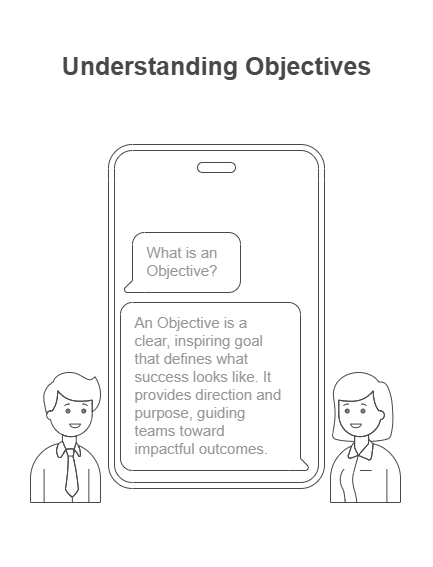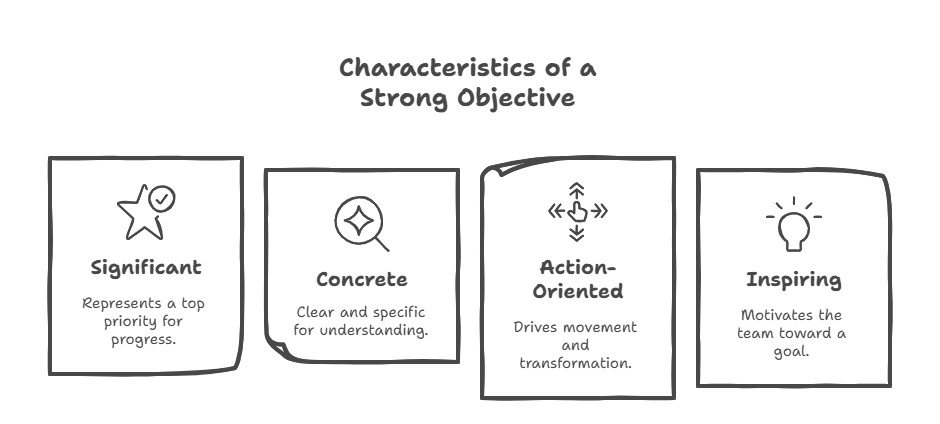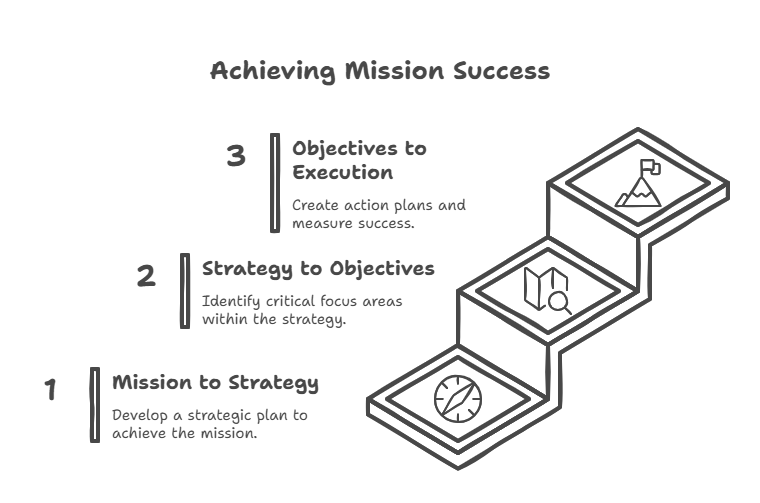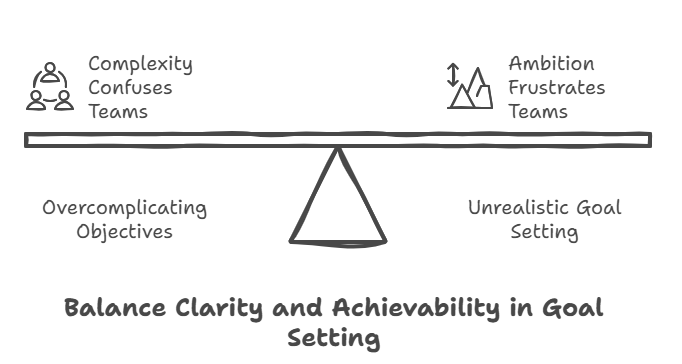
It’s crucial to understand the role of Objectives within the OKR framework, as they define what you aim to achieve and inspire your team to strive for greatness. This guide will equip you with insights into effective Objective-setting practices, common pitfalls to avoid, and various types of Objectives that align with your organizational goals. With a strategic approach to defining Objectives, you can enhance focus, accountability, and innovation throughout your organization, leading to measurable success in your initiatives.
Table of Contents
What is an Objective?
An Objective is a clear, inspiring goal that defines what success looks like. It provides direction and purpose, guiding teams toward impactful outcomes.
Understanding Objectives in OKRs
For organizations looking to enhance their strategic alignment and drive meaningful results, understanding Objectives in the OKR framework is necessary. Objectives serve as the heart of the framework, offering a clear vision and direction for teams to rally around. They inspire action and help prioritize what truly matters in achieving your overarching goals.
Definition and Purpose
One of the necessary elements of the OKR framework, Objectives are qualitative, aspirational, and time-bound goals that define what your organization aims to achieve. They answer the fundamental question: “What do we want to accomplish?” While Key Results focus on measurable outcomes, Objectives inspire and provide the “why” behind your efforts.
One key aspect of effective Objectives is their ability to be clear and inspirational, motivating your team to strive for meaningful achievements. Objectives should be ambitious yet achievable, pushing boundaries without becoming unrealistic, and they must be time-bound, associated with a specific timeframe. For example, stating, “Expand into three new geographic markets” sets a clear direction. Additionally, effective Objectives are qualitative, serving as the foundation for accomplishment tracked through measurable Key Results.
OKRs focus on creating effective Objectives that are memorable and align well with your overall organizational goals. By concentrating on a few key Objectives—ideally 3-5 per cycle—you can foster a sense of direction among your team. Staying clear of overcomplication ensures that your Objectives are easily understood and inspire action. By aligning your Objectives with the company’s mission, you cultivate a strong sense of collective ownership and commitment among team members.
Characteristics of a Strong Objective
As John Doerr says about Objectives, they should be:
- Significant: It must represent a top priority that drives meaningful progress.
- Concrete: Clear and specific enough for everyone to understand its importance.
- Action-Oriented: Drives movement, change, or transformation.
- Inspiring: Motivates and rallies the team toward a common goal.

Example of a Strong Objective
Instead of setting an Objective like “Increase market share”, a stronger alternative would be “Become the leading provider in our industry with the most customer referrals.” This version is more inspiring, specific, and action-oriented.
Writing a Great Objective
Before finalizing an Objective, ask these five questions:
- Is it driving an incremental change, a leap, or a discovery?
- Can it be made more specific?
- Is it action-oriented?
- Can it be framed more concisely?
- Is it memorable?
A vague Objective like “Improve customer satisfaction” could be strengthened as “Delight customers with the fastest and most personalized support experience.”
How Objectives Fit into Strategy & Execution
Many organizations struggle to turn strategy into execution. OKRs bridge this gap by ensuring that everyone is working towards the same priorities.
The Three-Step Flow:
- Mission → Strategy: Your strategy defines how to achieve the mission.
- Strategy → Objectives: The Objectives identify the most critical focus areas within the strategy.
- Objectives → Execution: The team creates action plans and Key Results to measure success.
Without well-defined Objectives, teams can get lost in competing priorities, working hard without making real progress.

Types of Objectives
Clearly, understanding the various types of Objectives within the OKR framework can help you set more effective goals. These types include:
| Strategic/Transformational Objectives | Long-term goals aimed at driving significant change or innovation. |
| Operational Objectives | Focused on improving existing processes or systems. |
| Committed Objectives | Critical goals that must be achieved within a cycle. |
| Aspirational/Stretch Objectives | Ambitious goals that drive innovation and effort. |
| Testing Objectives | Goals designed to explore new ideas or validate hypotheses. |
Thou should assess these categories to determine which aligns best with your organizational goals.
Strategic and Transformational Objectives
For organizations seeking substantial shifts, Strategic Objectives are vital. These long-term goals focus on transformative changes that can redefine your business landscape. An example would be a goal like, “Transition to a fully remote workforce by 2025,” which not only aims for flexibility but also fundamentally alters operational strategies.
Operational and Testing Objectives
Above all, Operational Objectives focus on refining existing processes, while Testing Objectives are about exploring novel ideas. For example, an Operational Objective could be to, “Reduce operational costs by 15% through process optimization.” In contrast, Testing Objectives like, “Test a new subscription pricing model in two markets,” venture into unknown territories to validate innovative approaches.
Consequently, these objectives are designed to harness your team’s strength towards continuous improvement and exploration. Operational Objectives help streamline processes, making your organization more efficient, while Testing Objectives encourage innovation and experimentation. It’s necessary to ensure that your objectives are not just achievable but also align with your overarching strategy, promoting a culture of accountability and adaptability.
Best Practices for Setting Objectives
Not every set goal leads to success; therefore, focus is crucial. To maximize impact, aim to limit yourself to 3-5 clear objectives per cycle. This approach prevents dilution of effort and encourages teams to concentrate on high-priority areas. When you have fewer objectives, you enhance accountability and foster a strong alignment within your team, ensuring everyone is moving towards the same destination.
Limitations and Focus
An effective strategy involves recognizing the limitations of your resources. A narrow focus enables your team to direct their energies toward the most impactful goals, ultimately leading to better outcomes. By setting manageable objectives, you create a pathway for real progress without overwhelming your team.
Alignment with Organizational Goals
To achieve meaningful results, it’s crucial that your objectives align with the broader organizational goals. This alignment helps ensure that all team members understand how their efforts contribute to the company’s mission and vision. When you establish objectives that build on your organization’s strategic direction, you’re more likely to inspire your team to perform at their best.
But aligning your objectives with organizational goals is not just about following a top-down approach. It’s about fostering a culture of collaboration and accountability. Ensure that your objectives resonate with your team’s values and aspirations while being supportive of the company’s mission. This alignment creates a strong sense of purpose, ultimately driving engagement and enhancing overall performance. The richer the connection between individual objectives and the organizational vision, the more effective your team will be in achieving their targets.
Common Pitfalls to Avoid
For effective goal-setting within the OKR framework, you must be aware of common pitfalls that can undermine your efforts. By understanding these issues, you can set clear, focused Objectives that align with your organization’s strategic vision. Avoiding these common mistakes will enhance team motivation, drive productivity, and ensure successful goal attainment.

Overcomplicating Objectives
About the importance of simplicity in your Objectives is paramount; when they become overly complex, they can confuse and demotivate your team. Instead of using jargon or convoluted language, strive for clarity. For instance, rather than saying, “Optimize cross-functional synergies to enhance value creation,” simply articulate the goal as, “Improve collaboration between sales and marketing teams.”
Unrealistic Goal Setting
With goal setting in the OKR framework, your Objectives should be ambitious yet achievable. Setting overly ambitious targets can lead to frustration and disengagement among team members. For example, instead of aiming to “Increase revenue by 500% in one quarter,” consider a more realistic challenge, such as “Increase revenue by 25% in one quarter.” By setting achievable goals, you can maintain team motivation and foster a culture of continuous improvement.
Objectives should inspire and drive effort, but when they are unrealistic, they can have the opposite effect. Achieving demanding goals can be motivating; however, if they are set too high, you risk alienating your team and stifling innovation. Hence, it’s necessary to set Objectives that push boundaries while remaining practical. Regularly assess your objectives to ensure they are both ambitious and feasible, promoting a healthy environment for progress.
The Role of Objectives in the OKR Framework
Despite the growing complexity of organizational goals, Objectives remain the cornerstone of the OKR framework, offering a clear vision that aligns teams and drives collective effort. By establishing what you aim to accomplish, Objectives guide your focus and foster a culture of accountability, ensuring everyone knows their role in reaching shared success.
Driving Focus and Accountability
An effective set of Objectives helps you prioritize your workload and eliminate distractions. By defining what matters most, you empower your teams to concentrate their efforts. This clarity not only enhances productivity but also instills a sense of ownership, as everyone understands how their contributions impact the overall goals.
Encouraging Innovation and Alignment
Any organization that aspires to thrive must seek to evolve, and Objectives can catalyze this process. By setting ambitious and aspirational goals, you challenge your teams to think outside the box, explore new ideas, and take calculated risks. At the same time, aligning these Objectives with the broader organizational mission fosters synergy, ensuring that all efforts are directed toward common outcomes.
Further, when you integrate ambitious Objectives within your framework, you create an environment ripe for taking calculated risks and exploring uncharted territories. This approach not only drives innovation but also reinforces alignment across departments, leading to a more cohesive strategy. By ensuring that your Objectives are aligned with your company’s mission and vision, you create a powerful synergy that enhances both morale and productivity, ultimately contributing to sustained success in your organization.
Practical Examples of Objectives
To effectively implement the OKR framework, it’s helpful to look at concrete examples of Objectives that resonate across various industries and organizations. Practical examples guide you in crafting your own Objectives that are clear, ambitious, and time-bound, ultimately driving focus and alignment within your team. These examples illustrate how diverse goals can motivate teams and lead to significant outcomes.
Objectives by Department
Along with understanding your team’s unique needs, it’s important to recognize that each department may have distinct Objectives that contribute to overarching organizational goals. For instance, while the marketing department might aim to increase brand awareness, the sales team may focus on revenue targets. Tailoring Objectives by department ensures that every facet of your organization is aligned and working towards shared objectives.
Cross-Functional Objective Setting
After aligning departmental goals, consider adopting a cross-functional approach to Objective setting that fosters collaboration and innovation. Engaging different teams in the Objective-setting process can help create Objectives that leverage diverse perspectives, resources, and expertise, leading to richer outcomes and improved organizational cohesion.
Examples of this approach include setting a shared Objective between the marketing and sales teams to “Increase market share by 10% in the next year.” This type of collaboration not only enhances team synergy but also aligns each department’s efforts toward a common goal. By tactically combining input from various departments, you can address potential challenges collectively and boost accountability, resulting in more productive outcomes across your organization.
Conclusion
Presently, you have a comprehensive understanding of the significance of Objectives in the OKR framework. By setting clear, inspiring, and aligned Objectives, you can enhance focus, accountability, and innovation within your organization. This guide equips you with the best practices and common pitfalls to avoid, empowering you to integrate OKRs effectively with other management frameworks. Ultimately, mastering Objectives will enable you to drive your teams towards achieving meaningful and impactful goals.
Key Takeaways:
- Objectives are qualitative, aspirational goals that provide vision and direction within the OKR framework, answering the question, “What do we want to accomplish?”
- Effective Objectives should be clear, inspirational, ambitious yet achievable, time-bound, and qualitative, serving as guiding principles for teams.
- Types of Objectives include strategic, operational, committed, aspirational, and testing, each serving different purposes to drive organizational success.
- Best Practices for setting Objectives involve limiting the number of Objectives, ensuring alignment with organizational goals, and fostering team collaboration in the goal-setting process.
- Alignment between Objectives and other management frameworks, such as SMART goals, the Balanced Scorecard, and Agile methodology, enhances their effectiveness in achieving business results.
FAQs about Objectives
What are Objectives in the OKR framework?
Objectives in the OKR framework are qualitative, aspirational, and time-bound goals that define what an organization, team, or individual aims to achieve. They answer the question, “What do we want to accomplish?” Unlike Key Results, which are quantitative and measurable, Objectives are designed to inspire and provide direction.
What characteristics make an effective Objective?
Effective Objectives have several key characteristics: they are clear and inspirational, making them easy to understand and motivating for teams; they are ambitious yet achievable, pushing boundaries without being unrealistic; they are time-bound, tied to specific timeframes; and they are qualitative, supported by measurable Key Results.
What are some types of Objectives that organizations can set?
Objectives can be categorized into several types based on their purpose and scope:
1. Strategic/Transformational Objectives, aimed at driving significant change.
2. Operational Objectives, focused on improving existing processes.
3. Committed Objectives, critical goals that must be met within a cycle.
4. Aspirational/Stretch Objectives, ambitious goals that drive innovation.
5. Testing Objectives, designed to explore new ideas or validate hypotheses.
What are best practices for setting Objectives in the OKR framework?
Best practices for setting Objectives include limiting the number of Objectives to 3-5 per cycle to maintain focus, aligning them with organizational goals, involving teams in the objective-setting process to foster ownership, communicating them clearly across the organization, and making them memorable by using simple, concise language.
How do Objectives in OKRs relate to other management frameworks?
Objectives in OKRs can relate closely to other frameworks like SMART goals, which emphasizes specific and relevant aspects, and the Balanced Scorecard, which focuses on multiple organizational perspectives. Additionally, OKRs complement Agile methodology by providing a strategic goal-setting framework. They also build on Management by Objectives (MBO) by incorporating measurable Key Results and enhancing transparency and alignment across the organization.

[…] Objectives in the OKR Framework: The Ultimate Guide […]
[…] Objectives in the OKR Framework: The Ultimate Guide […]